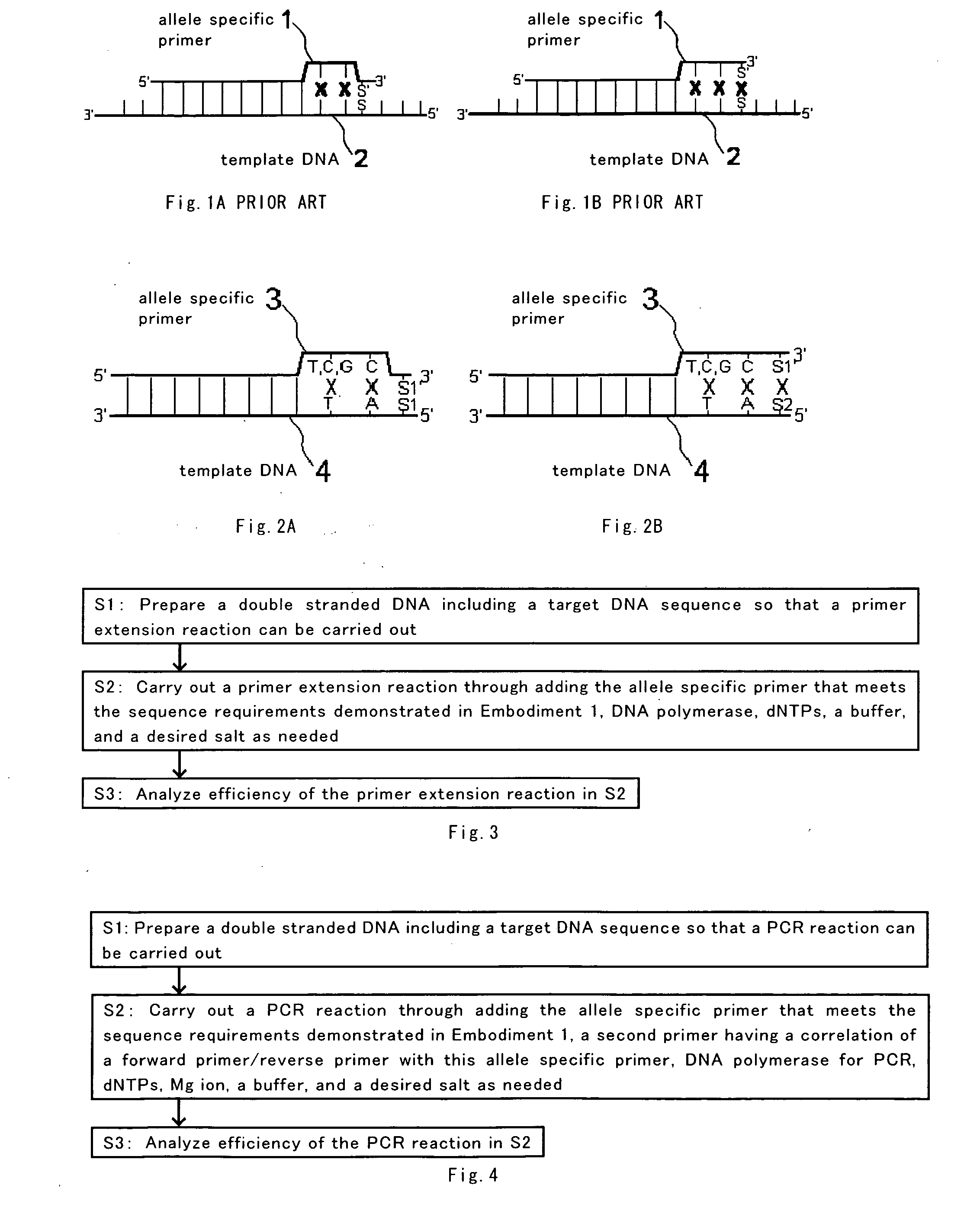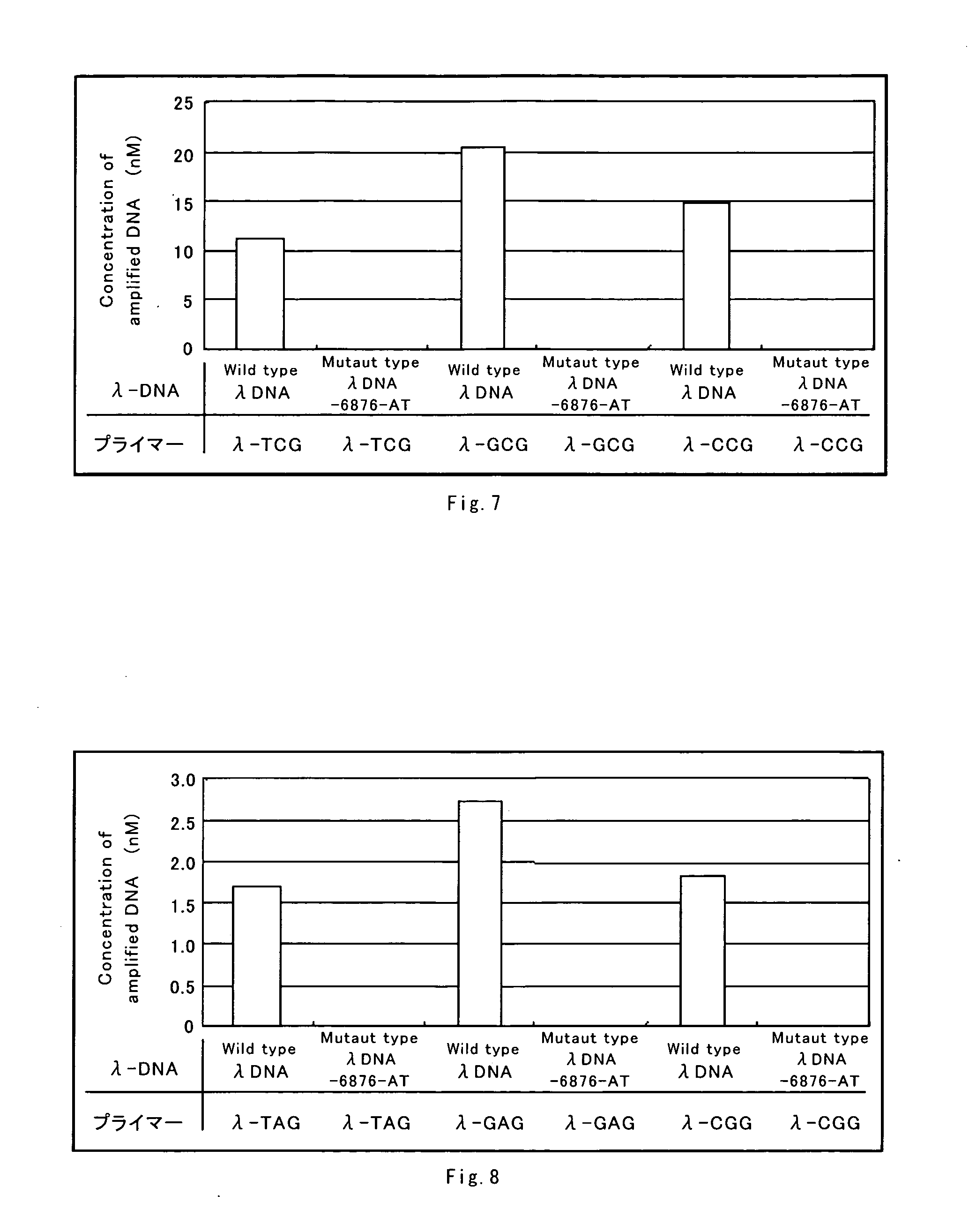Discrimination method of target base in DNA, and allele specific primer used in the method of the same
a technology of allele specific primers and target bases, which is applied in the field of discrimination methods of target bases in dna, and allele specific primers used in the same field, can solve the problems of extremely inferior efficiency of primer extension reaction and allele specific primers proposed
- Summary
- Abstract
- Description
- Claims
- Application Information
AI Technical Summary
Benefits of technology
Problems solved by technology
Method used
Image
Examples
embodiment 1
[0053] In this Embodiment 1, base type requirements for the allele specific primer according to the present invention will be explained with reference to FIGS. 2A and 2B.
[0054] In the present invention, as shown in FIGS. 2A and 2B, the target DNA sequence to be a subject includes the target SNP base present at the 5′ end, the second base from the 5′ end being A and the third base from the 5′ end being T.
[0055] In order to facilitate understanding of the present invention, it is assumed that the target SNP base is present at the 5′ end in FIGS. 2A and 2B. However, in general, the target SNP base may be present anywhere in the target DNA sequence, as shown in FIGS. 1A and 1B, and it is not necessary to exist at the 5′ end of the target DNA sequence.
[0056] Because the 3′ end base of the allele specific primer is a base corresponding to SNP, in case where there are two kinds of predicted base type at the target SNP (denoted as S1, S2 in FIGS. 2A and 2B), the 3′ end base of the allele...
embodiment 2
[0066] In this Embodiment 2, a method of discriminating SNP by carrying out a primer extension reaction using an allele specific primer according to the present invention will be explained.
[0067] As shown in FIG. 3, a double stranded DNA including a target DNA sequence is first prepared so that a primer extension reaction can be carried out. In the target DNA sequence requirements, the target SNP base is present at the 5′ end, with the second base from the 5′ end being A and the third base from the 5′ end being T, similarly to Embodiment 1.
[0068] Therefore, the complementary chain sequence of the target DNA sequence has its 3′ end base being complementary to the target SNP base, with the second base from the 3′ end being T and the third base from the 3′ end being A.
[0069] The double stranded DNA that meets such sequence requirements is prepared to provide the state to permit the primer extension reaction to be carried out as described above. Thus, a primer extension reaction may ...
embodiment 3
[0082] In this Embodiment 3, a method of discriminating SNP by carrying out PCR using the allele specific primer according to the present invention will be explained.
[0083] As shown in FIG. 4, a double stranded DNA including a target DNA sequence is first prepared so that a PCR reaction can be carried out. In the target DNA sequence requirements then, the target SNP base is present at the 5′ end, with the second base from the 5′ end being A and the third base from the 5′ end being T, similarly to Embodiment 1.
[0084] Therefore, the complementary chain sequence of the target DNA sequence has its 3′ end base being complementary to the target SNP base, with the second base from the 3′ end being T and the third base from the 3′ end being A.
[0085] The double stranded DNA that meets such sequence requirements is prepared to give the state to permit the PCR reaction to be carried out as described above. Thus, a PCR reaction may be carried out through adding the allele specific primer tha...
PUM
| Property | Measurement | Unit |
|---|---|---|
| wavelength | aaaaa | aaaaa |
| DNA elongation | aaaaa | aaaaa |
| concentration | aaaaa | aaaaa |
Abstract
Description
Claims
Application Information
 Login to View More
Login to View More - R&D
- Intellectual Property
- Life Sciences
- Materials
- Tech Scout
- Unparalleled Data Quality
- Higher Quality Content
- 60% Fewer Hallucinations
Browse by: Latest US Patents, China's latest patents, Technical Efficacy Thesaurus, Application Domain, Technology Topic, Popular Technical Reports.
© 2025 PatSnap. All rights reserved.Legal|Privacy policy|Modern Slavery Act Transparency Statement|Sitemap|About US| Contact US: help@patsnap.com



